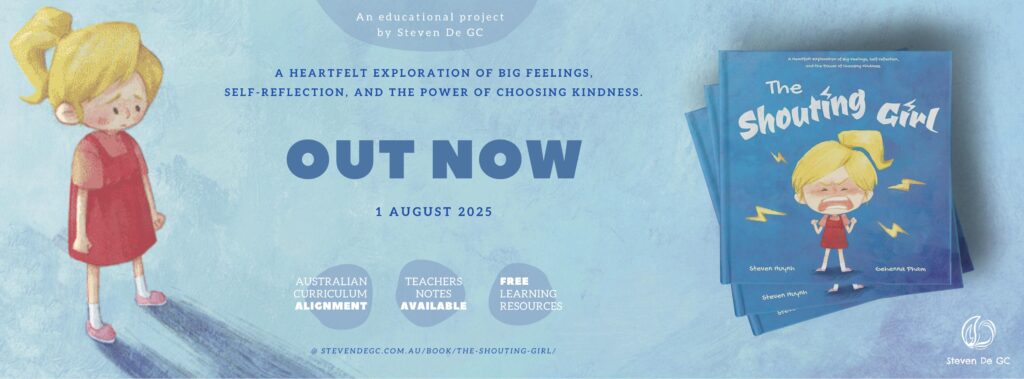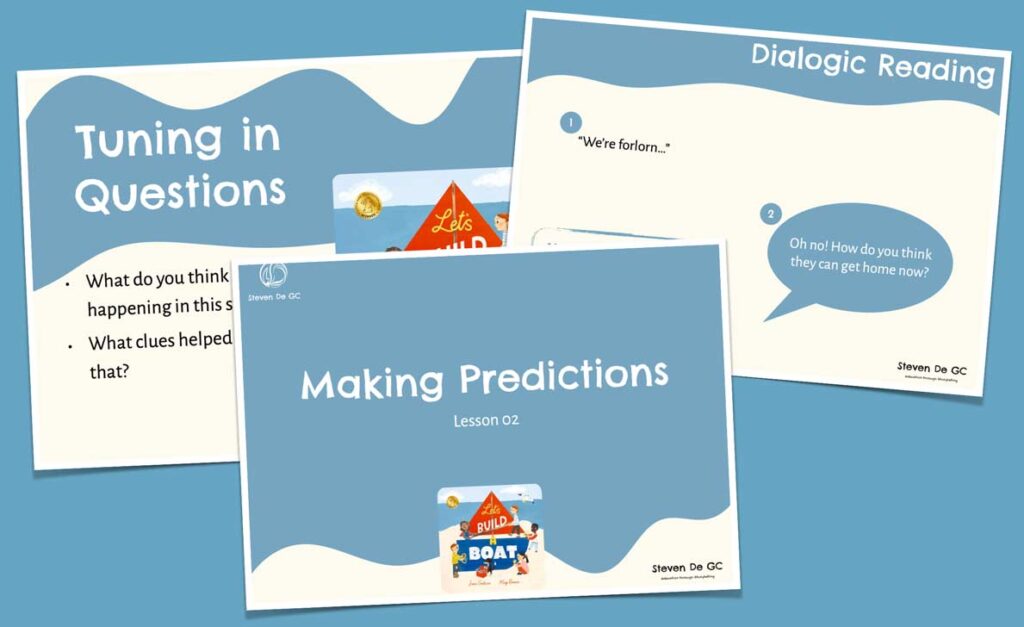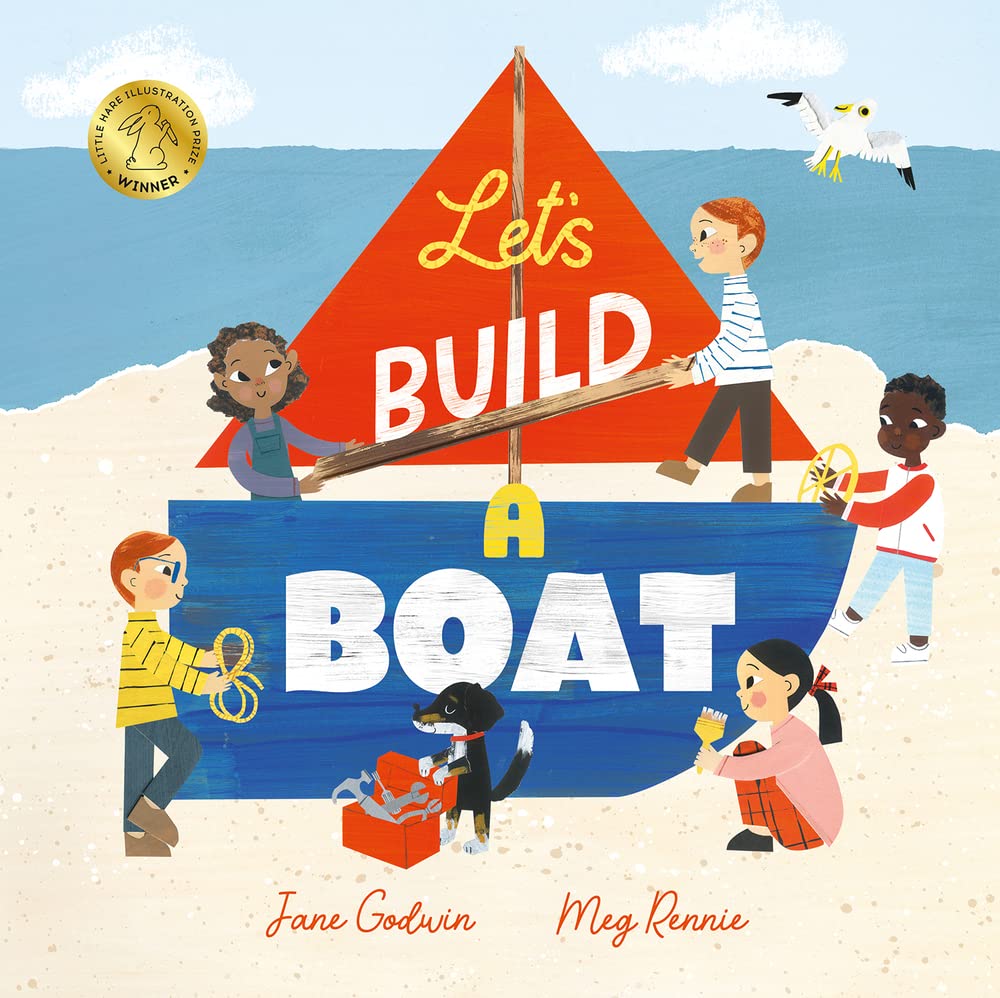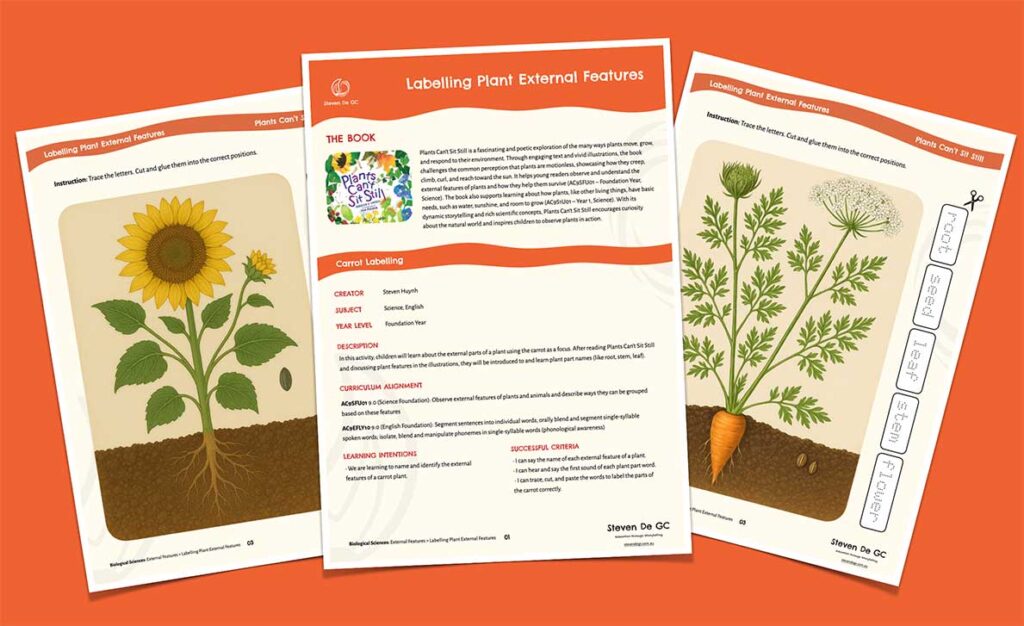Warm-Up
- Recap: Briefly revisit what students saw last time (cover, video, wonderings). Ask:
- “What do you think is happening in this story?”
- “What clues helped you think that?”
- Prompt students to refer to illustrations or parts of the book introduced previously.
Dialogic Reading – Making Predictions
- Explain: “Today we’re going to read more of the story. While we read, we’ll stop and think about what might happen next. That’s called making a prediction.”
- Begin reading Let’s Build a Boat aloud with fluency and expression.
- Pause at key points to ask prediction questions, such as:
- What do you think they will use to build the boat?
- Do you think the 3 boys know what their friends are doing? Will they help them?
- Do you think the boat will float? Why or why not?
- What are they doing on the island?
- What do you think will happen to them or the boat?
- Will the boy be rescued?
- How do you think they can get home now?
- Can they fix their boat?
- How many people were on the boat?
- Prompt students to explain their thinking using sentence starters:
- “I think… because…”
- “Maybe… because I see…”
Discussion – Initial Responses
- After reading the story, ask:
- “What do you think about the story?”
- “Why do you think they made the boat?”
Reflection – Add to the Wonderings Page
- Revisit the wonderings page from Lesson 1.
- Invite students to add more details based on their new thoughts after reading the story.
- Prompts for this update:
- “How was the story different from your original thoughts?”
- “What happened in the story?”
- “Were your ‘wonders’ answered?”
- “Is there anything that still puzzles you?” (e.g., “What makes a good boat?”, “How do you stop it from sinking?”)





![[T4R] Let’s Build a Boat Reading/Design Unit for Year 1/2 [T4R] Let’s Build a Boat Reading/Design Unit for Year 1/2](https://stevendegc.com.au/wp-content/uploads/2025/05/LetsBuildaBoat-T4R-Overview-Cover-1024x626.jpg)
![[T4R] Let’s Build a Boat: L11 Evaluation and Reflection [T4R] Let’s Build a Boat: L11 Evaluation and Reflection](https://stevendegc.com.au/wp-content/uploads/2025/05/LetsBuildaBoat-T4R-Lesson11-Cover-1024x626.jpg)
![[T4R] Let’s Build a Boat: L10 Summarising [T4R] Let’s Build a Boat: L10 Summarising](https://stevendegc.com.au/wp-content/uploads/2025/05/LetsBuildaBoat-T4R-Lesson10-Cover-1024x626.jpg)
![[T4R] Let’s Build a Boat: L9 Making Inferences [T4R] Let’s Build a Boat: L9 Making Inferences](https://stevendegc.com.au/wp-content/uploads/2025/05/LetsBuildaBoat-T4R-Lesson9-Cover-1024x625.jpg)
![[T4R] Let’s Build a Boat: L6 Writing a Boat-making Procedure [T4R] Let’s Build a Boat: L6 Writing a Boat-making Procedure](https://stevendegc.com.au/wp-content/uploads/2025/05/LetsBuildaBoat-T4R-Lesson6-Cover-1024x626.jpg)
![[T4R] Let’s Build a Boat: L5 Connecting to a Different Text [T4R] Let’s Build a Boat: L5 Connecting to a Different Text](https://stevendegc.com.au/wp-content/uploads/2025/05/LetsBuildaBoat-T4R-Lesson5-Cover-1024x626.jpg)
![[T4R] Let’s Build a Boat: L4 Literal Retrieval [T4R] Let’s Build a Boat: L4 Literal Retrieval](https://stevendegc.com.au/wp-content/uploads/2025/05/LetsBuildaBoat-T4R-Lesson4-Cover-1024x626.jpg)
![[T4R] Let’s Build a Boat: L3 Making Connections [T4R] Let’s Build a Boat: L3 Making Connections](https://stevendegc.com.au/wp-content/uploads/2025/05/LetsBuildaBoat-T4R-Lesson3-Cover-1024x625.jpg)
![[T4R] Let’s Build a Boat: L1 Background Knowledge [T4R] Let’s Build a Boat: L1 Background Knowledge](https://stevendegc.com.au/wp-content/uploads/2025/05/LetsBuildaBoat-T4R-L1-Cover-1024x626.jpg)

![[T4R] A Family is a Family is a Family: L6 Reflecting and Evaluating [T4R] A Family is a Family is a Family: L6 Reflecting and Evaluating](https://stevendegc.com.au/wp-content/uploads/2025/03/T4R-A-Family-is-a-Family-L6-Cover-1024x627.jpg)
Leave a Reply